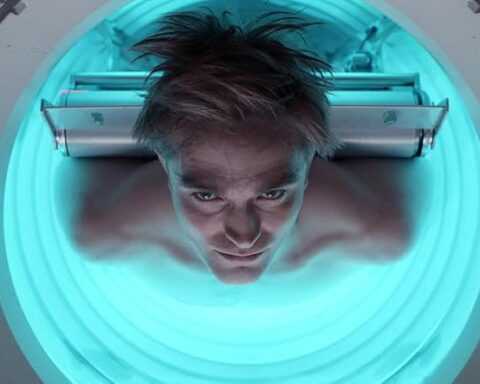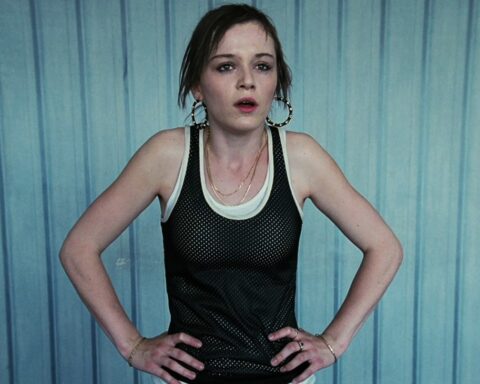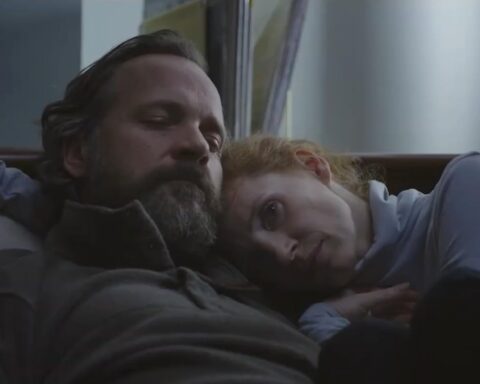Nu Astepta Prea Mult de la Sfârsitul Lumii (2023)
Radu Jude, unhesitatingly digging the end of the world along with his country Romania. Criticism, irony, and sharp humor from Polish poet Stanislaw Jerzy Lec’s aphorism “Do Not Expect Too Much of the End of the World” are present in the film, with or without depth, multi-layered stories, and their perfect harmony and disharmony, perfection, and anti-perfection; as we know Radu Jude does it again… But still, in a way we never expected. How does Jude manage to do this even in our era?
We start the film with Angela, who can barely wake up in the early darkness. Other than a book by her side and a half-empty wine bottle, we have no idea about Angela yet. She sets off wearing a sequined dress that won’t be at all compatible with the places she’ll enter.
Throughout most of the film, we focus on Angela, trapped in the front seat, continuing to drive while cursing her employer and the drivers who react to her, feeling trapped in her car, exhausted. The audience experiences Angela’s distress through camera and sound design: besides close-ups of Angela, we see what she sees from the car window, we hear what she hears on the radio, we struggle with her with the gear stick. And then, occasionally, she takes a breath; Bobitta, produced by Angela as an escape from this demanding daily routine, brings color to the film, departing from the monochrome palette. Angela creates an other, rough in appearance, absurd in expression, foul-mouthed yet possessing practical intelligence and knowledgeable enough to reference literature. Angela doesn’t just aim to escape from her misogynistic, racist, and extremely repulsive character, she also reveals that she transforms masculine toxicity in this way, saving herself from her anger and criticizing this domination. Then, one more surprise: she even meets the cult German director Uwe Böll on a film set and conducts an interview; just like her, Bobitto swears at her own haters, while Uwe swears at snobbish critics.
What we understand from Angela’s daily experiences is a tableau of contemporary Romania encompassing the institutionalized exploitation of the capitalist system, the moral decay it causes, criticisms of governance, and much more. The situation of the Romanian company holding meetings with Austria for a safety video, serving as a metaphor for the relationship between impoverished Eastern Europe and wealthy Western Europe. Some of the points successfully touched upon by Jude include capitalist greed, the slavery metaphor attempted to be disguised in every possible way but never successfully concealed, and the decadence brought by worker exploitation reaching extreme levels. Karl Marx’s work has transformed Bucharest into a postmodern ornament in a residence piercing through it. Not only that, through the character played by Nina Hoss, Doris Goethe, the director delivers her main message by sticking the needle into her own country: “If the West did these, it’s the Romanian government that gave them the authority…”
Doris, representing the Austrian company, is portrayed as a capitalist deity with a giant silhouette covering her presentation background with “sacred plazas”. Then, during her brief visit to the company in Romania, the only thing Doris is impressed by in the city is, unsurprisingly, the single and grotesque “Ceaușescu Palace” in the middle of the city. Pay attention to her surname: Goethe, and yes, she is indeed from that lineage. When Angela, whom we understand to be a bookworm, says what a great privilege it is by quoting Goethe, Doris brushes it off with a bitter truth: when you’re from such a family, this cultural heritage becomes a burden, and you want to ignore it, escape from it. This scene is a slap in the face felt by the audience about how capitalism empties real spiritual values.
Perhaps the most beautiful moments of the film occur on the journey Angela takes with Doris from the airport: when Angela says she’ll avoid a road that has caused six hundred deaths so far, Jude stops the film for a significant period, mutes all sounds; and the camera shows all 600 crosses, in honor of the 600 deaths. Because human life is very valuable despite the negligence and indifference of the authorities.
One of the characters in the film talks about Jean-Luc Godard ending his life with euthanasia. Through his extraordinary dialectical approach, Radu disturbs and challenges the audience by collaging genres, forms, and styles using his complex and multi-layered stories created by moving forward and backward in time and employing different perspectives and attempting all these cinematic techniques. Just like Godard, a magnificent tribute to the master director… “Godard is like a god to me. He is everywhere.” RJ
Touches of mise en abyme in the film
We dive into a second story set in the Ceaușescu era, with a taxi driver, from a parallel universe, shown alongside a film from the 80s Romania, “Angela moves on” (1981). There are similarities and differences between the two characters. The story of the old Angela is a beautifully restored color film, while the color palette of the new Angela is sepia-like, dark, greenish, high-contrast black and white; portraying an almost collapsing dystopian universe. While the old film represents a city story through censorship, the new film embraces the dystopian environment of capitalism. Despite fifty years difference, what happens to the old Angela happens to the new Angela in similar ways.
Dorina Lazar, who portrays the old Angela, now joins the present with her aged self. Moreover, she takes on a crucial role as the head of a family that the young Angela interviews for a job, whose son is now confined to a wheelchair and hopes to appear in the safety video looking for candidates for the accident he suffered. In this video, which aims to exonerate the Austrian company from the accident, and is devoid of truth, Jude will stain everyone’s hands with the blood of workers.
Jude has a beautiful touch in the old film: although censored, in some sequences of the old film, he uses slow motion, even extreme slow motion, to highlight details that escape censorship and to depict a reality different from the reality the totalitarian regime wants to show; for example, people lining up in front of a store or scenes where we see poverty itself.
Through an experimental narrative structure merging meta-theatrically, these two films promise that Jude will never give up trying new techniques.
Ultimately, “Do Not Expect Too Much of the End of the World” is a monument to the courage of Radu Jude, one of the bravest directors of our time, a testament to his ability to narrate dystopia with comedy. To conclude in his own words; “In fact, the fact that my films could be bad liberates me.”
Having premiered at the Locarno IFF and returned with a jury award, “Do Not Expect Too Much of the End of the World” currently has 3 awards and 3 nominations. The film is also Romania’s Oscar nominee.
Watched it at: Film Fest Gent
by Nil Birinci










